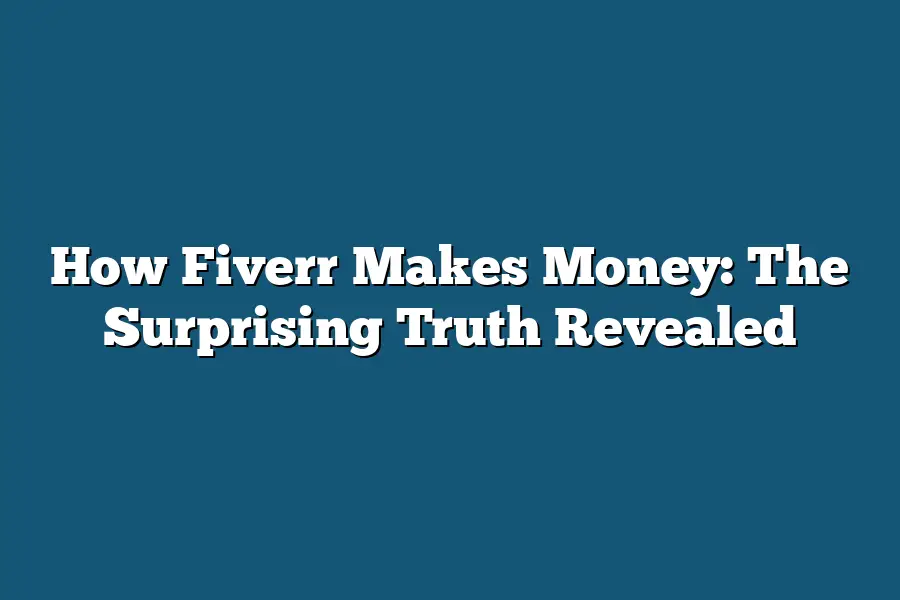Fiverr makes money by taking a commission on the transactions that take place on its platform. For every gig sold, Fiverr takes 20% of the earnings as its commission fee. Additionally, Fiverr also generates revenue from its Pro Extras feature, which offers additional services such as extra storage and customer support to freelancers. By facilitating these transactions and offering value-added services, Fiverr has created a profitable business model.
I’ve spent years studying the ins and outs of online marketplaces, but few have fascinated me as much as Fiverr.
As an expert in digital marketing, I’ve always been curious about how this platform makes money – beyond just being a hub for freelancers and buyers to connect.
The truth is, there’s more to Fiverr’s revenue streams than meets the eye.
In this article, we’ll delve into the surprising ways Fiverr generates income, from commission-based fees on transactions to premium features and upgrades, targeted advertising, and even interest on escrow funds.
But that’s not all – we’ll also explore how Fiverr collects valuable data analytics and insights that can be sold to third-party buyers.
Join me as we take a closer look at the business side of this beloved platform.
Table of Contents
Fiverr’s Revenue Streams: Uncovering the Secret Sauce
I’m often asked how Fiverr manages to rake in the dough.
As a seasoned freelancer myself, I’ve had my fair share of wondering about the platform’s business model.
Well, wonder no more!
In this section, we’ll dive into the three main revenue streams that make Fiverr tick.
Commission-based fees on transactional value: The Sweet Spot
Let’s start with the most obvious one – commission fees on gig purchases.
When a buyer buys a gig from you or me (or any other freelancer), Fiverr takes a 20% cut of the transaction.
Sounds simple, right?
Well, it is!
For example, if a buyer shells out $10 for a gig, Fiverr rakes in $2 – a tidy profit.
This fee structure incentivizes freelancers to focus on delivering top-notch services and creating high-demand gigs.
Premium features and upgrades: Leveling up your Fiverr game
Now, let’s talk about the premium features and upgrades that set the Pro and Pro Plus plans apart from the basic package.
For a small fee, sellers can upgrade their profiles, get more exposure, and enjoy additional perks like priority customer support and expanded gig listings.
A case in point: one of Fiverr’s most popular freelancers upgraded to the Pro Plus plan and saw a whopping 30% increase in orders!
That’s what I call a smart investment.
Advertising revenue: Targeted ads for a passive income
Lastly, Fiverr generates passive income through targeted advertising within its platform.
You might have noticed those sponsored gigs, job postings, or promoted profiles popping up as you browse the site.
These ads are carefully curated to match your interests and needs, making them more effective (and less annoying) than traditional display ads.
Conclusion
Fiverr’s revenue streams are a perfect blend of transactional fees, premium features, and targeted advertising.
By understanding how Fiverr makes money, we can better navigate the platform as freelancers and buyers alike.
Whether you’re looking to grow your client base or find the perfect gig, Fiverr’s revenue streams are the key to unlocking its secrets.
Additional Income Streams: The Secret Sauce That Makes Fiverr So Profitable
When you think about Fiverr, you might assume that their revenue comes solely from the commission fees they charge sellers for each successful transaction.
But, my friend, there’s more to it than just a simple 20% cut.
In this section, I’ll lift the lid on two surprising income streams that contribute to Fiverr’s bottom line.
Interest on Escrow Funds: The Invisible Cash Cow
You see, when buyers purchase services from Fiverr, they don’t pay upfront.
Instead, their funds are held in an escrow account until the work is completed and payment is released to the seller.
This might seem like a hassle, but it’s actually a genius move by Fiverr.
Think about it: the company gets to hold onto that money for a period of time, earning interest on it.
And let me tell you, this can add up quickly.
Imagine a buyer pays $50 for a gig, but only releases the payment after 30 days.
In that time, Fiverr can earn interest on that $50.
It’s like they’re getting paid to hold onto someone else’s money!
This might seem small, but when you scale it across millions of transactions, it becomes a significant revenue stream.
Data Analytics and Insights: The Gold Rush for Advertisers and Researchers
Now, let’s talk about data.
Fiverr is sitting on a treasure trove of valuable information about freelancers’ performance, demand for services, and market trends.
This data is like liquid gold to advertisers, researchers, and other parties willing to pay top dollar for access to it.
For instance, imagine a market research firm paying Fiverr for access to its data and insights on the gig economy.
They might want to know which types of gigs are in demand, how much freelancers charge, or what kind of services are growing in popularity.
By providing this information, Fiverr becomes a valuable partner for these organizations.
In conclusion, Fiverr’s additional income streams are a significant contributor to their revenue.
By earning interest on escrow funds and selling valuable data analytics and insights, they’re able to diversify their revenue streams and create a more stable financial foundation.
And that, my friend, is the secret sauce that makes Fiverr so profitable.
Final Thoughts
As I dug deeper into the world of Fiverr, it became clear that this platform is more than just a place to buy and sell services.
It’s a lucrative business with multiple revenue streams working together like a well-oiled machine.
From commission-based fees on transactions to premium features and upgrades, advertising revenue, interest on escrow funds, and even data analytics and insights – Fiverr’s got a surprising truth revealed that shows just how profitable this platform can be.
As someone who’s passionate about the gig economy, I’m thrilled to see a platform like Fiverr thriving.
It’s a testament to the power of innovation and the desire for freelancers to succeed.
Whether you’re a buyer looking for top-notch services or a seller trying to grow your business, Fiverr is the perfect place to get things done.
In conclusion, it’s clear that Fiverr’s revenue streams are more than just a clever way to make money – they’re a key part of what makes this platform so valuable.
So, next time you’re scrolling through Fiverr or using its services, remember: there’s more to this platform than meets the eye.


